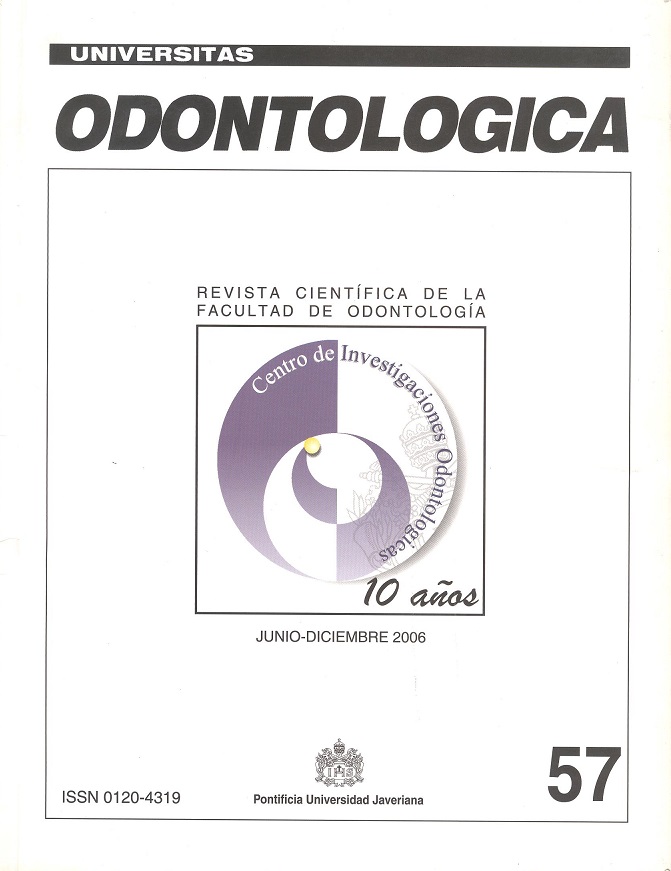Resumen
En el pasado el fibroblasto fue considerado una célula sencilla, cuya función carecía de complejidad al ser considerado simplemente como una estructura de soporte para otros tipos celulares. Sin embargo, en la actualidad, este concepto ha sido totalmente reevaluado, y es posible encontrar en los fibroblastos un universo estructural y funcional muy particular. Teniendo en cuenta que el fibroblasto constituye el componente principal de los tejidos conectivos del cuerpo, es de gran interés el conocer su origen, estructura, funciones y la existencia de una heterogeneidad poblacional, con el fin de comprender posteriormente, su importancia dentro de la salud y enfermedad periodontal. A partir de esto, el presente artículo de revisión intenta dar al lector un recorrido a través de las características de los fibroblastos gingivales y del ligamento periodontal, con el fin de proporcionar un fundamento para la comprensión de la fisiología del desarrollo de la enfermedad periodontal y el rol del fibroblasto como protagonista en todos los procesos determinantes del origen y cicatrización de los tejidos periodontales.
In the past, the fibroblast was considered a simple cell, whose function was limited to the support of other types of cells, lacking complexity. Now, this concept has been totally updated, and it is possible to find within fibroblasts a very particular structural and functional universe.Taking into account that the fibroblast is the main component of the connective tissues of the body, it is really interesting to get to know its origin, structure, functions and the existence of cell heterogeneity, in order to understand its further importance within periodontal health and disease. This review article aims to bring the reader along gingival and periodontal ligament fibroblasts characteristics, to bring the basis for comprehension of the physiology of periodontal disease and the role of the fibroblast as main character in all the processes determining origin and healing of periodontal tissues.
Phipps RP, Borrello MA, Blieden TM. Fibroblast heterogeneity in the periodontium and other tissues, 1997 Jan; 32 (1 Pt 2): 159-65.
Genco RJ. Host responses in periodontal diseases: current concepts. J Periodontol 1992; 63: 338-55.
Ten Cate AR. Oral histology: development, structure and function. 5a. ed., Editorial Mosby Inc., 1998.
Pitaru S, Mc Culloch CAG, et al. Cellular origins and differentiation control mechanisms during periodontal development and wound healing. J Periodont Res, 1994; 29: 81-94.
Lekic P and McCulloch CAG. Periodontal ligament cell populations: the central role of fibroblasts in creating a unique tissue. The Anatomical Record 1996; 245: 327-41.
Geneser F. Histología, 2a. ed., Editorial Médica Panamericana. Argentina 1993; 153.
Amar, S and Chung, KM. Clinical implications of cellular biologic advances in periodontal regeneration. Current Opinion in Periodontology 1994; 128-40.
Hassell TM and Stanek EJ. Evidence that healthy human gingiva contains functionally heterogeneous fibroblast subpopulations. Archs Oral Biol 1983; 28: 617-25.
Larjava H, Sandberg M, Vuorio E. Altered distribution of type I collagen mRNA in periodontal disease. J Periodont Res 1989; 24: 171-7.
Narayanan AS, Clagett JA, PAge RC. Effect of inflammation on the distribution of collagen types I, II, IV and V and type I trimer and fibronectin in human gingiva. J Dent Res 1985; 64: 1111-6.
Limeback HF, Sodek J, Aubin JE. Variation in collagen expression of cloned periodontal ligament cells. J Periodont Res 1983; 18: 242-8.
Rose GG, Yamasaki A, Pinero GJ, Mahan CJ. Human periodontal ligament cells in vitro. J Periodont Res 1987; 22: 20-8.
Giannopolou C, Cimasoni G. Functional characteristics of gingival and periodontal ligament fibroblasts. J Dent Res 1996; 75 (3): 895-902.
Mariotti A and Cochran DL. Characterization of fibroblasts derived from human periodontal ligament and gingiva. J Periodontol 1990; 61: 103-11.
Han X and Amar S. Identification of genes differentially expressed in cultured human periodontal ligament fibroblasts vs. Human gingival fibroblasts by DNA microarray analysis. J Dent Res 2002; 81 (6): 399-405.
Hou, LT and Yaeger JA. Cloning and characterization of human gingival and periodontal ligament fibroblasts. J Periodontol 1993; 64: 1209.
Ogata Y, Niisato N et al. Comparison of the characteristics of human gingival fibroblasts and periodontal ligament cells. J Periodontol 1995; 66: 1025-31.
Somerman MJ, Archer SY et al. A comparative study of human periodontal ligament cells and gingival fibroblasts in vitro. J Dental Res 1988; 67: 66-70.
Offenbacher S, Farr DH, Goodson JM. Measurement of prostaglandin E in crevicular fluid. J Clin Periodontol 1981; 8: 359-67.
Ivanovski S, Li H, Haase HR, Bartold PM. Expression of bone associated macromolecules by gingival and periodontal ligament fibroblasts.
J Periodont Res 2001; 36: 131-41.
Esta revista científica se encuentra registrada bajo la licencia Creative Commons Reconocimiento 4.0 Internacional. Por lo tanto, esta obra se puede reproducir, distribuir y comunicar públicamente en formato digital, siempre que se reconozca el nombre de los autores y a la Pontificia Universidad Javeriana. Se permite citar, adaptar, transformar, autoarchivar, republicar y crear a partir del material, para cualquier finalidad (incluso comercial), siempre que se reconozca adecuadamente la autoría, se proporcione un enlace a la obra original y se indique si se han realizado cambios. La Pontificia Universidad Javeriana no retiene los derechos sobre las obras publicadas y los contenidos son responsabilidad exclusiva de los autores, quienes conservan sus derechos morales, intelectuales, de privacidad y publicidad.
El aval sobre la intervención de la obra (revisión, corrección de estilo, traducción, diagramación) y su posterior divulgación se otorga mediante una licencia de uso y no a través de una cesión de derechos, lo que representa que la revista y la Pontificia Universidad Javeriana se eximen de cualquier responsabilidad que se pueda derivar de una mala práctica ética por parte de los autores. En consecuencia de la protección brindada por la licencia de uso, la revista no se encuentra en la obligación de publicar retractaciones o modificar la información ya publicada, a no ser que la errata surja del proceso de gestión editorial. La publicación de contenidos en esta revista no representa regalías para los contribuyentes.


